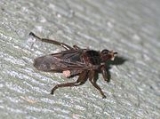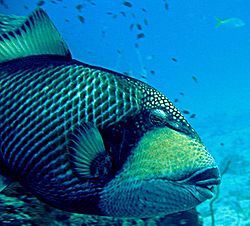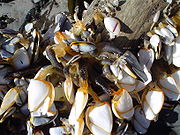
Commensalism
Encyclopedia

Ecology
Ecology is the scientific study of the relations that living organisms have with respect to each other and their natural environment. Variables of interest to ecologists include the composition, distribution, amount , number, and changing states of organisms within and among ecosystems...
, commensalism is a class of relationship between two organisms where one organism benefits but the other is neutral (there is no harm or benefit). There are two other types of association: mutualism (where both organisms benefit) and parasitism
Parasitism
Parasitism is a type of symbiotic relationship between organisms of different species where one organism, the parasite, benefits at the expense of the other, the host. Traditionally parasite referred to organisms with lifestages that needed more than one host . These are now called macroparasites...
(one organism benefits and the other one is harmed).
Commensalism derives from the English
English language
English is a West Germanic language that arose in the Anglo-Saxon kingdoms of England and spread into what was to become south-east Scotland under the influence of the Anglian medieval kingdom of Northumbria...
word commensal, meaning "sharing of food" in human social interaction, which in turn derives from the Latin
Latin
Latin is an Italic language originally spoken in Latium and Ancient Rome. It, along with most European languages, is a descendant of the ancient Proto-Indo-European language. Although it is considered a dead language, a number of scholars and members of the Christian clergy speak it fluently, and...
cum mensa, meaning "sharing a table". Originally, the term was used to describe the use of waste food by second animals, like the carcass eaters that follow hunting animals, but wait until they have finished their meal.
Examples of commensal relationships
Commensalism is harder to demonstrate than parasitism and mutualism, for it is easier to show a single instance whereby the host is affected, than it is to prove or disprove that possibility. Often, a detailed investigation will show that the host indeed has become affected by the relationship.Cattle egrets and livestock
An example of commensalism: cattle egretsCattle Egret
The Cattle Egret is a cosmopolitan species of heron found in the tropics, subtropics and warm temperate zones. It is the only member of the monotypic genus Bubulcus, although some authorities regard its two subspecies as full species, the Western Cattle Egret and the Eastern Cattle Egret...
foraging in fields among cattle
Cattle
Cattle are the most common type of large domesticated ungulates. They are a prominent modern member of the subfamily Bovinae, are the most widespread species of the genus Bos, and are most commonly classified collectively as Bos primigenius...
or other livestock. As cattle, horse
Horse
The horse is one of two extant subspecies of Equus ferus, or the wild horse. It is a single-hooved mammal belonging to the taxonomic family Equidae. The horse has evolved over the past 45 to 55 million years from a small multi-toed creature into the large, single-toed animal of today...
s and other livestock graze on the field, they cause movements that stir up various insects. As the insects are stirred up, the cattle egrets following the livestock catch and feed upon them. The egrets benefit from this relationship because the livestock have helped them find their meals, while the livestock are typically unaffected by it.
Tigers and golden jackals
In India, lone golden jackalGolden Jackal
The golden jackal , also known as the common jackal, Asiatic jackal, thos or gold-wolf is a Canid of the genus Canis indigenous to north and northeastern Africa, southeastern and central Europe , Asia Minor, the Middle East and southeast Asia...
s expelled from their pack have been known to form commensal relationships with tiger
Tiger
The tiger is the largest cat species, reaching a total body length of up to and weighing up to . Their most recognizable feature is a pattern of dark vertical stripes on reddish-orange fur with lighter underparts...
s. These solitary jackals, known as kol-bahl, will attach themselves to a particular tiger, trailing it at a safe distance in order to feed on the big cat's kills. A kol-bahl will even alert a tiger to a kill with a loud pheal (thereby straying into mutualism). Tigers have been known to tolerate these jackals: one report describes how a jackal confidently walked in and out between three tigers walking together a few feet away from each other. Tigers will however kill jackals on occasion: the now extinct tigers of the Amu Darya
Amu Darya
The Amu Darya , also called Oxus and Amu River, is a major river in Central Asia. It is formed by the junction of the Vakhsh and Panj rivers...
region were known to eat jackals frequently.
Other examples
Another example of commensalism: birdsBird
Birds are feathered, winged, bipedal, endothermic , egg-laying, vertebrate animals. Around 10,000 living species and 188 families makes them the most speciose class of tetrapod vertebrates. They inhabit ecosystems across the globe, from the Arctic to the Antarctic. Extant birds range in size from...
following army ant
Army ant
The name army ant is applied to over 200 ant species, in different lineages, due to their aggressive predatory foraging groups, known as "raids", in which huge numbers of ants forage simultaneously over a certain area, attacking prey en masse.Another shared feature is that, unlike most ant...
raids on a forest floor
Forest floor
The forest floor, also called detritus, duff and the O horizon, is one of the most distinctive features of a forest ecosystem. It mainly consists of shed vegetative parts, such as leaves, branches, bark, and stems, existing in various stages of decomposition above the soil surface...
. As the army ant colony travels on the forest floor, they stir up various flying insect species. As the insects flee from the army ants, the birds following the ants catch the fleeing insects. In this way, the army ants and the birds are in a commensal relationship because the birds benefit while the army ants are unaffected.
Orchids and moss
Moss
Mosses are small, soft plants that are typically 1–10 cm tall, though some species are much larger. They commonly grow close together in clumps or mats in damp or shady locations. They do not have flowers or seeds, and their simple leaves cover the thin wiry stems...
es are plants that can have a commensal relationship with trees. The plants grow on the trunks or branches of trees. They get the light they need as well as nutrients that run down along the tree. As long as these plants do not grow too heavy, the tree is not affected.
Barnacles

Barnacle
A barnacle is a type of arthropod belonging to infraclass Cirripedia in the subphylum Crustacea, and is hence related to crabs and lobsters. Barnacles are exclusively marine, and tend to live in shallow and tidal waters, typically in erosive settings. They are sessile suspension feeders, and have...
s are highly sedentary crustaceans that must attach themselves permanently to a hard substrate, such as rocks, shells, whales or anything else on which they can gain a foothold. When they attach to the shell of a scallop
Scallop
A scallop is a marine bivalve mollusk of the family Pectinidae. Scallops are a cosmopolitan family, found in all of the world's oceans. Many scallops are highly prized as a food source...
, for instance, barnacles benefit by having a place to stay, leaving the scallop presumably unaffected.
Arguments
Whether the relationship between humans and some types of our gut floraGut flora
Gut flora consists of microorganisms that live in the digestive tracts of animals and is the largest reservoir of human flora. In this context, gut is synonymous with intestinal, and flora with microbiota and microflora....
is commensal or mutualistic is still unanswered.
Some biologists argue that any close interaction between two organisms is unlikely to be completely neutral for either party, and that relationships identified as commensal are likely mutualistic or parasitic
Parasitism
Parasitism is a type of symbiotic relationship between organisms of different species where one organism, the parasite, benefits at the expense of the other, the host. Traditionally parasite referred to organisms with lifestages that needed more than one host . These are now called macroparasites...
in a subtle way that has not been detected. For example, epiphytes are "nutritional pirates" that may intercept substantial amounts of nutrients that would otherwise go to the host plant. Large numbers of epiphytes can also cause tree limbs to break or shade the host plant and reduce its rate of photosynthesis. Similarly, phoretic mites may hinder their host by making flight more difficult, which may affect its aerial hunting ability or cause it to expend extra energy while carrying these passengers.
Types

Symbiosis
Symbiosis is close and often long-term interaction between different biological species. In 1877 Bennett used the word symbiosis to describe the mutualistic relationship in lichens...
to brief, weak interactions through intermediaries.
Phoresy: One animal attaching to another for transportation only. This concerns mainly arthropod
Arthropod
An arthropod is an invertebrate animal having an exoskeleton , a segmented body, and jointed appendages. Arthropods are members of the phylum Arthropoda , and include the insects, arachnids, crustaceans, and others...
s, examples of which are mite
Mite
Mites, along with ticks, are small arthropods belonging to the subclass Acari and the class Arachnida. The scientific discipline devoted to the study of ticks and mites is called acarology.-Diversity and systematics:...
s on insect
Insect
Insects are a class of living creatures within the arthropods that have a chitinous exoskeleton, a three-part body , three pairs of jointed legs, compound eyes, and two antennae...
s (such as beetle
Beetle
Coleoptera is an order of insects commonly called beetles. The word "coleoptera" is from the Greek , koleos, "sheath"; and , pteron, "wing", thus "sheathed wing". Coleoptera contains more species than any other order, constituting almost 25% of all known life-forms...
s, flies
Fly
True flies are insects of the order Diptera . They possess a pair of wings on the mesothorax and a pair of halteres, derived from the hind wings, on the metathorax...
or bee
Bee
Bees are flying insects closely related to wasps and ants, and are known for their role in pollination and for producing honey and beeswax. Bees are a monophyletic lineage within the superfamily Apoidea, presently classified by the unranked taxon name Anthophila...
s), pseudoscorpion
Pseudoscorpion
A pseudoscorpion, , is an arachnid belonging to the order Pseudoscorpionida, also known as Pseudoscorpiones or Chelonethida....
s on mammal
Mammal
Mammals are members of a class of air-breathing vertebrate animals characterised by the possession of endothermy, hair, three middle ear bones, and mammary glands functional in mothers with young...
s or beetles, and millipede
Millipede
Millipedes are arthropods that have two pairs of legs per segment . Each segment that has two pairs of legs is a result of two single segments fused together as one...
s on bird
Bird
Birds are feathered, winged, bipedal, endothermic , egg-laying, vertebrate animals. Around 10,000 living species and 188 families makes them the most speciose class of tetrapod vertebrates. They inhabit ecosystems across the globe, from the Arctic to the Antarctic. Extant birds range in size from...
s. Phoresy can be either obligate or facultative (induced by environmental conditions).
Inquilinism
Inquiline
In zoology, an inquiline is an animal that lives commensally in the nest, burrow, or dwelling place of an animal of another species. For example, some organisms such as insects may live in the homes of gophers and feed on debris, fungi, roots, etc...
: Using a second organism for housing. Examples are epiphytic
Epiphyte
An epiphyte is a plant that grows upon another plant non-parasitically or sometimes upon some other object , derives its moisture and nutrients from the air and rain and sometimes from debris accumulating around it, and is found in the temperate zone and in the...
plant
Plant
Plants are living organisms belonging to the kingdom Plantae. Precise definitions of the kingdom vary, but as the term is used here, plants include familiar organisms such as trees, flowers, herbs, bushes, grasses, vines, ferns, mosses, and green algae. The group is also called green plants or...
s (such as many orchids) that grow on trees, or birds that live in holes in trees.
Metabiosis: A more indirect dependency, in which one organism creates or prepares a suitable environment for a second. Examples include maggots, which feast and develop on corpses, and hermit crab
Hermit crab
Hermit crabs are decapod crustaceans of the superfamily Paguroidea. Most of the 1100 species possess an asymmetrical abdomen which is concealed in an empty gastropod shell that is carried around by the hermit crab.-Description:...
s, which use gastropod shells to protect their bodies.
See also
- SymbiosisSymbiosisSymbiosis is close and often long-term interaction between different biological species. In 1877 Bennett used the word symbiosis to describe the mutualistic relationship in lichens...
- long-term interactions between different biological species, which can be mutualistic, commensal or parasitic - Mutualism - where both organisms experience mutual benefit in the relationship
- ParasitismParasitismParasitism is a type of symbiotic relationship between organisms of different species where one organism, the parasite, benefits at the expense of the other, the host. Traditionally parasite referred to organisms with lifestages that needed more than one host . These are now called macroparasites...
- where one organism benefits at the expense of another - RemoraRemoraThe remora , sometimes called a suckerfish or sharksucker, is an elongated, brown fish in the order Perciformes and family Echeneidae...
- phoretic fishes that may also eat the scraps off their hosts, though they may also be mutualistic cleanersCleaner fishCleaner fish are fish that provide a service to other fish species by removing dead skin and ectoparasites. This is an example of mutualism, an ecological interaction that benefits both parties involved. A wide variety of fishes have been observed to display cleaning behaviors including wrasses,...

